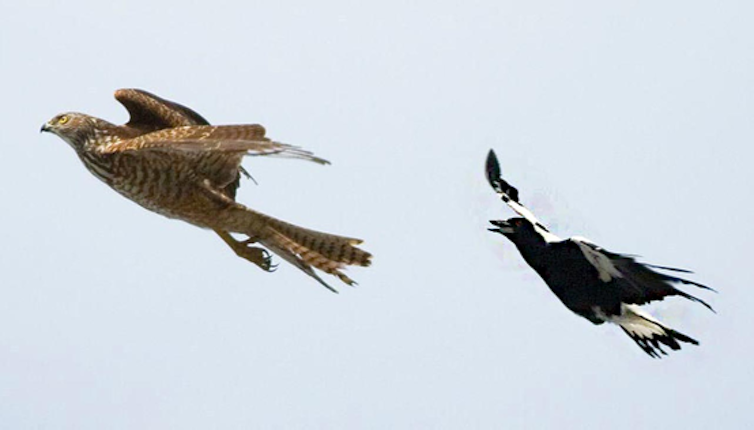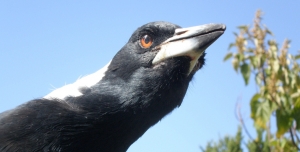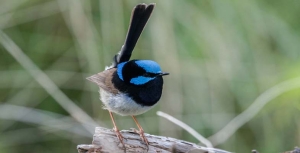Displaying items by tag: birds
Website for Bird Watching Enthusiasts
We recently received a message from a fellow bird enthusiast about his blog called the Ultimate Beginners Guide to Bird Watching. It has a North American focus but has lots of useful information.
The blog has been written by Jonny who has been an avid bird watcher for well over 20 years. As he says birding is ‘a hobby, I can’t recommend it highly enough, so get out there and enjoy nature at its finest’.
Magpies can Form Friendships with People – Here's How
Can one form a friendship with a magpie – even when adult males are protecting their nests during the swooping season? The short answer is: 'Yes, one can' - although science has just begun to provide feasible explanations for friendship in animals, let alone for cross-species friendships between humans and wild birds.
Ravens and magpies are known to form powerful allegiances among themselves. In fact, Australia is thought to be a hotspot for cooperative behaviour in birds worldwide. They like to stick together with family and mates, in the good Australian way.
Of course, many bird species may readily come to a feeding table and become tame enough to take food from our hand, but this isn’t really 'friendship'. However, there is evidence that, remarkably, free-living magpies can forge lasting relationships with people, even without depending on us for food or shelter.
When magpies are permanently ensconced on human property, they are also far less likely to swoop the people who live there. Over 80% of all successfully breeding magpies live near human houses, which means the vast majority of people, in fact, never get swooped. And since magpies can live between 25 and 30 years and are territorial, they can develop lifelong friendships with humans. This bond can extend to trusting certain people around their offspring.
A key reason why friendships with magpies are possible is that we now know that magpies are able to recognise and remember individual human faces for many years. They can learn which nearby humans do not constitute a risk. They will remember someone who was good to them; equally, they remember negative encounters.
Why become friends?
Magpies that actively form friendships with people make this investment (from their point of view) for good reason. Properties suitable for magpies are hard to come by and the competition is fierce. Most magpies will not secure a territory – let alone breed – until they are at least five years old. In fact, only about 14% of adult magpies ever succeed in breeding. And based on extensive magpie population research conducted by R. Carrick in the 1970s, even if they breed successfully every single year, they may successfully raise only seven to eleven chicks to adulthood and breeding in a lifetime. There is a lot at stake with every magpie clutch.
Read more: Bird-brained and brilliant: Australia’s avians are smarter than you think
The difference between simply not swooping someone and a real friendship manifests in several ways. When magpies have formed an attachment they will often show their trust, for example, by formally introducing their offspring. They may allow their chicks to play near people, not fly away when a resident human is approaching, and actually approach or roost near a human.
In rare cases, they may even join in human activity. For example, magpies have helped me garden by walking in parallel to my weeding activity and displacing soil as I did. One magpie always perched on my kitchen window sill, looking in and watching my every move.
On one extraordinary occasion, an adult female magpie gingerly entered my house on foot, and hopped over to my desk where I was sitting. She watched me type on the keyboard and even looked at the screen. I had to get up to take a phone call and when I returned, the magpie had taken up a position at my keyboard, pecked the keys gently and then looked at the 'results' on screen.
The bird was curious about everything I did. She also wanted to play with me and found my shoelaces particularly attractive, pulling them and then running away a little only to return for another go.
Importantly, it was the bird (not hand-raised but a free-living adult female) that had begun to take the initiative and had chosen to socially interact and such behaviour, as research has shown particularly in primates, is affiliative and part of the basis of social bonds and friendships.
Risky business
If magpies can be so good with humans how can one explain their swooping at people (even if it is only for a few weeks in the year)? It’s worth bearing in mind that swooping magpies (invariably males on guard duty) do not act in aggression or anger but as nest defenders. The strategy they choose is based on risk assessment.
A risk is posed by someone who is unknown and was not present at the time of nest building, which unfortunately is often the case in public places and parks. That person is then classified as a territorial intruder and thus a potential risk to its brood. At this point the male guarding the brooding female is obliged to perform a warning swoop, literally asking a person to step away from the nest area.
If warnings are ignored, the adult male may try to conduct a near contact swoop aimed at the head (the magpie can break its own neck if it makes contact, so it is a strategy of last resort only). Magpie swooping is generally a defensive action taken when someone unknown approaches who the magpie believes intends harm. It is not an arbitrary attack.

When I was swooped for the first time in a public place I slowly walked over to the other side of the road. Importantly, I allowed the male to study my face and appearance from a safe distance so he could remember me in future, a useful strategy since we now know that magpies remember human faces. Taking a piece of mince or taking a wide berth around the magpies nest may eventually convince the nervous magpie that he does not need to deter this individual anymore because she or he poses little or no risk, and who knows, may even become a friend in future.
A sure way of escalating conflict is to fence them with an umbrella or any other device, or to run away at high speed. This human approach may well confirm for the magpie that the person concerned is dangerous and needs to be fought with every available strategy.
![]() In dealing with magpies, as in global politics, de-escalating a perceived conflict is usually the best strategy.
In dealing with magpies, as in global politics, de-escalating a perceived conflict is usually the best strategy.
Gisela Kaplan, Professor of Animal Behaviour, University of New England
This article was originally published on The Conversation. Read the original article.
It isn't Easy being Blue – Cost of Colour in Fairy Wrens
Male superb fairy-wrens change colour every year, from dull brown to bright blue. But being blue may be risky if you are a tiny bird that is easily spotted by predators.
This new study found that male fairy-wrens adjust their risk-taking behaviour after undergoing colour change, becoming more cautious while brightly coloured.
Colour and Risk
For many males, having beautiful colours is important for attracting choosy females. Researchers think attractive colours come with a cost, so that only the highest quality males can afford to display them. This may be helpful to females looking to select the best mate.
One possible cost of bright colours is increased predation risk, as bright animals are easily seen in their natural habitat. This cost can be dramatic (i.e. being eaten) but may more often involve changes in behaviour to mitigate risk, such as spending more time scanning for predators and being more responsive to perceived threats. Such behaviours are costly because they reduce the time available for foraging and are energetically expensive.
A relationship between bright colours, predation risk and cautious behaviour may seem intuitive; however this is difficult to test. This is because different coloured animals may also differ in their age, size, escape tactics and personality, which can influence both their behaviour and actual predation risk.
To address this, we tested whether individuals adjust their response to risk according to changes in their plumage colour.
Fairy-wren Antics
Superb fairy-wrens are small, charismatic songbirds. They live in groups with a dominant male and female and, often, several younger males.
These birds are vulnerable to predators such as kookaburras, butcherbirds, currawongs and goshawks. When a group member spots a predator, it gives an alarm call to warn the others. In response, other group members may race for cover, or ignore the alarm and continue about their business.
Male fairy-wrens change colour by replacing dull brown feathers with bright blue, black and indigo ones prior to breeding, turning brown again after the breeding season is complete. Individuals change colour at different times of the year, ranging from the Australian autumn (March to April) to late spring (October).

Although female fairy-wrens have a stable, social partner, when egg-laying time comes, they briefly leave their territory under the cover of darkness and “visit” the male who became blue earliest in the year. Many of the females in the surrounding area prefer the same male, who may father around 70% of the offspring in the neighbourhood. These attractive males are blue for longest (remaining blue for 10-12 months of the year) and so may face the greatest risk of predation.
Tracking fairy-wrens
We gave fairy-wrens different coloured leg bands, allowing us to follow the same individuals over time.

We compared the behaviour of the same males while they were brown and blue, as well as males that remained brown or blue throughout the study. This meant we could test for the effect of colour on responses to perceived risk while accounting for individual differences and possible seasonal changes in behaviour.
We estimated cautiousness in the birds by testing their response to alarm calls. This involved sneaking up on unsuspecting fairy-wrens in their natural habitat and broadcasting fairy-wren alarm calls from portable speakers.
We used two types of alarms: a low-danger alarm, which warns of a moderate threat, such as a predator that is far away, and a high-danger alarm, which signals an immediate threat.
Costs of being Blue
Responses to the low-danger alarm included fleeing for cover, an intermediate response (such as ducking or looking skywards) and no response, when the alarm was ignored. Fairy-wrens fled immediately after hearing the high-danger alarm, but differed in the time taken to return to the open.
We found that fairy-wrens were more cautious while blue; they fled more often after hearing low-danger alarms and took longer to emerge from hiding after fleeing in response to high-danger alarms. Blue fairy-wrens also spent more time scanning their surroundings and less time foraging compared to brown wrens.
This suggests that fairy-wrens perceive themselves to be at a higher risk of predation while bright blue and adjust their behaviour accordingly.

Blue Decoys?
Intriguingly, fairy-wrens also adjusted their behaviour according to the colour of other wrens in the group. When a blue male was nearby, wrens were less responsive to alarm calls and devoted less time to keeping a look-out.
Perhaps this is because fairy-wrens view blue group members as colourful decoys in the event of an attack. This could occur if predators are biased towards attacking the most conspicuous animal, which reduces the predation risk for surrounding individuals. Brown wrens could also be taking advantage of the greater time blue males spend scanning, allowing them to lower their guard.
Being blue for longest gives males the best chance of attracting females, but they need to be extra careful lest they get eaten before it comes to that.
![]() Coauthors on this research are Annalise Naimo, Niki Teunissen, Robert Magrath and Kaspar Delhey.
Coauthors on this research are Annalise Naimo, Niki Teunissen, Robert Magrath and Kaspar Delhey.
Alexandra McQueen, PhD Candidate in Behavioural Ecology, Monash University and Anne Peters, Associate Professor, Monash University
This article was originally published on The Conversation. Read the original article.
Bubbles not Balloons
Every day there’s an outdoor event to celebrate or commemorate something or other, and balloons will be released. It looks spectacular for a moment or two, but they’re soon forgotten. What happens to them? Most end up in our seas, where they are eaten by marine wildlife, including seabirds. It sounds frivolous, but it’s become a major conservation problem.
BirdLife Australia has thrown its support behind a campaign by Zoos Victoria and the Phillip Island Nature Parks to shine a spotlight on this issue.
Most people aren’t even aware that the simple act of releasing balloons into the air poses a major danger to wildlife. However, the facts are startling. A CSIRO study found that balloons are in the top three most harmful pollutants threatening marine wildlife – along with plastic bags and bottles.
Albatrosses, cormorants, penguins and pelicans are all affected by this, but of all Australia’s seabirds, shearwaters, or muttonbirds, are the most badly affected when it comes to ingesting plastic debris.
For example, the decline of Flesh-footed Shearwaters on Lord Howe Island has been directly linked to the ingestion of debris, with balloons and their plastic attachments, one of the most prevalent and readily identifiable items found inside them. Further, two separate studies have found that 100% of Short-tailed Shearwaters contain plastic in their digestive systems.
The balloons fill the birds’ digestive tracts while offering no nutrition, and slowly poison them as toxic chemicals leach into the birds’ tissues.
Birdlife Australia is joining Zoos Victoria and Phillip Island Nature Parks to encourage Australians to make their outdoor events wildlife-friendly. The best way to do this is by choosing to use bubbles instead of balloons to reduce this source of harmful waste.
Help spread the word to use bubbles instead of balloons at outdoor events. It’s a simple act but it can make such a big difference.
This information comes from Birdlife Australia.
Further reading:
Ever-changing Birds of Northern Sydney
Ross Rapmund gave a fascinating talk on the changing birds in northern Sydney. He started with a slide which compared the ten most common birds before 1900 with recent data. A hundred years ago the most common species were small birds with an average weight of 18 g (e.g. Superb Fairy Wren, New Holland Honeyeater, Golden Whistler and Willie Wagtail). Now the most common birds are much bigger with an average weight of 180 g (e.g. Common Myna, Noisy Miner, Magpie, Currawong and Rainbow Lorikeet).
A Threatening Species: The Noisy Miner
Residents of Sydney's suburbs cannot help but notice the abundance of the native honeyeater, the noisy miner (Manorina melanocephala) in their gardens and their aggressive defence of their territory against other birds of all sizes and almost anything else (eg bats, cats, koalas and cows). One wonders if they can cause damage to the ecological balance of areas where they dominate.
The Noisy Miner: A Friend not a Pest?
STEP member Ralph Pridmore describes his personal experiences with his local feathered friends.
What Plastic is doing to Marine Life
The impact on marine life from plastic may be most obvious in coastal regions, but in August CSIRO released the results of the first analysis of the threat posed by plastic pollution to pelagic bird species worldwide. The report is published by the National Academy of Sciences of the US.




